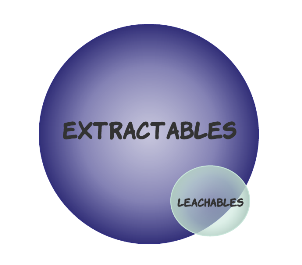Extractables/Leachables
CPG performs extractables and leachable studies for product development, quality control, and regulatory approval for pharmaceuticals, medical devices, food products, cosmetics, and packaging.
What are leachables and extractables?

Extractables are compounds that can be removed from a product or material when subjected to a solvent. Extraction studies are often used to replicate the worst case scenario of how many compounds in a device or product could become leachables. Extraction studies may be used to determine additive concentrations in materials by removing all of the leachable material, and then quantifying it. These studies are often required by the FDA and other regulatory bodies.
Leachables are compounds that migrate from a product into a surrounding media under intended use conditions, or from a material in contact with a product into said product. Often times, the material in contact with the product is plastic packaging, particularly in the pharmaceutical area.
Leachable compounds may include:
- Plastic additives, such as stabilizers and processing aids
- Monomers or low molecular weight species
- Manufacturing residues
- Inks and adhesives from secondary packaging
Leachable compounds from packaging can affect the drug product, modifying its behavior or introducing potentially harmful products to the patient along with the drug. Similarly, materials leaching from implants can potentially have an effect on the patient. Alternatively, leaching is desired in some materials, such as antibiotic elution from permanent implants.
Leaching studies are carried out under simulated conditions that mimic normal usage.
Leaching and Extraction Conditions
Scientists at CPG design simulated conditions to mimic the relevant environment for the product in question.
These conditions may be:
- Shelf-storage conditions for packaging studies
- In vivo environment for medical device behavior
- Animal studies
For extraction studies, the relevant solvent for extraction is selected based on the leachable component in question, along with extraction conditions (temperature and duration).
Leachables/Extractables Analysis
The analysis technique to identify and quantify the leaching or extraction behavior is selected based on the leachable compounds in question, but usually include one or more of the following:
- UHPLC-UV-ELSD-QTOF-MS
- GC-MS
- HS-GC-MS
- HPLC
- UV-Vis
- FTIR
- TOC
Analysis is often performed in time studies, to determine the elution rate as a function of exposure time.
Relevant Standards
- ASTM D1045 Standard Test Methods for Sampling and Testing Plasticizers Used in Plastics
- ASTM D7823 Test Method for Determination of Low Level, Regulated Phthalates in Poly (Vinyl Chloride) Plastics by Thermal Desorption — Gas Chromatography/Mass Chromatography
- ASTM WK43975 New Practice for Determining and Characterizing Extractables from Materials Used in Single-use Applications
- USP <1663>Assessment of Extractables Associated with Pharmaceutical Packaging/Delivery Systems
- USP <1664> Assessment of Drug Product Leachables Associated with Pharmaceutical Packaging Delivery Systems
- ISO 10993-12 Sample Preparation and Reference Materials
- ISO 10993-18:20 Chemical Characterization of Medical Device Materials Within a Risk Management Process
Contact us to have a discussion with one of our scientists about your project or to request a quote.
